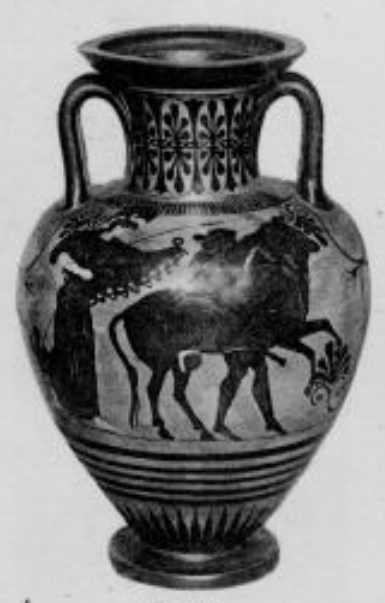Chapter 7: The Royal House of Athens
Previous Page Table of Contents Next Page
♠ Euripides, Aigeus fr 9 N² – Tragicorum Graecorum Fragmenta, pp. 364-65, ed. A. Nauck, 2nd ed. Leipzig 1889.
♠ Euripides, Aigeus fr 10 N² – Tragicorum Graecorum Fragmenta, p. 365, ed. A. Nauck, 2nd ed. Leipzig 1889.
♠ Euripides, Aigeus fr 11 N² – Tragicorum Graecorum Fragmenta, pp. 365, ed. A. Nauck, 2nd ed. Leipzig 1889.
♦ Florence, Museo Archeologico Etrusco, 91456: Attic red-figure cup with Theseus and the Marathonian Bull

E. Pfuhl, Malerei und Zeichnung der Griechen vol. 3 (1923) pl. 101 fig. 351
Beazley Archive Pottery Database
♦ London, British Museum, E36: Attic red-figure cup with Theseus and the Marathonian Bull (on left)


C.H. Smith, Catalogue of the Greek and Etruscan Vases in the British Museum, vol. 3 (1896), pl. 2
Beazley Archive Pottery Database
♦ Paris, Musée de Louvre F271: Attic black-figure amphora with Theseus and the Marathonian Bull

Corpus Vasorum Antiquorum, Louvre 5 , France 8 (1928), pl. 56.10
Beazley Archive Pottery Database
♦ Paris, Cabinet des Médailles 536 and 647: Attic red-figure cup by the Kleophrades Painter with Marathonian Bull, Theseus and Athena

J.C. Hoppin, Euthymides and his Fellows (1917), pl. 44
Beazley Archive Pottery Database
♠ Sophokles, Aigeus fr 25 R – Tragicorum Graecorum Fragmenta vol. 4, p. 126, ed. S. L. Radt. Göttingen 1977.
♠ Isokrates, Speeches 10. Helen 25
Theseus, however, being his own master, gave preference to those struggles which would make him a benefactor of either the Greeks at large or of his native land. Thus, the bull let loose by Poseidon which was ravaging the land of Attica, a beast which all men lacked the courage to confront, Theseus singlehanded subdued, and set free the inhabitants of the city from great fear and anxiety. Greek Text
♠ DS 4.59.6 – Diodoros Siculus, Library of History
After successfully accomplishing the deeds which we have mentioned, Theseus came to Athens and by means of the tokens caused Aegeus to recognize him. Then he grappled with the Marathonian bull which Heracles in the performance of one of his Labours had brought from Crete to the Peloponnesus, and mastering the animal he brought it to Athens; this bull Aegeus received from him and sacrificed to Apollo. Greek Text
♠ ApB 2.5.7 – Apollodoros, Library (Bibliotheke)
The seventh labour he enjoined on him was to bring the Cretan bull. Acusilaus says that this was the bull that ferried across Europa for Zeus; but some say it was the bull that Poseidon sent up from the sea when Minos promised to sacrifice to Poseidon what should appear out of the sea. And they say that when he saw the beauty of the bull he sent it away to the herds and sacrificed another to Poseidon; at which the god was angry and made the bull savage. To attack this bull Hercules came to Crete, and when, in reply to his request for aid, Minos told him to fight and catch the bull for himself, he caught it and brought it to Eurystheus, and having shown it to him he let it afterwards go free. But the bull roamed to Sparta and all Arcadia, and traversing the Isthmus arrived at Marathon in Attica and harried the inhabitants. Greek Text
♠ Fab 38 – Hyginus, Fabulae
He killed the bull at Marathon, which Hercules had brought to Eurystheus from Crete. Latin Text
♠ Philochoros 328F109 FGrH – Die Fragmente der griechischen Historiker 3, p. 130, ed. F. Jacoby, 2d ed. Leiden 1957.
♠ Kallimachus, Hekale – Callimachus, ed. R. Pfeiffer 1, pp. 226-303. Oxford 1949-53
Previous Page Table of Contents Next Page
Artistic sources edited by R. Ross Holloway, Elisha Benjamin Andrews Professor Emeritus, Joukowsky Institute for Archaeology and the Ancient World, Brown Univ., July 2016; and by Frances Van Keuren, Prof. Emerita, Lamar Dodd School of Art, Univ. of Georgia, January 2017.
Literary sources edited by Patrick Dix, Graduate Teaching Assistant, University of Georgia Classics Departments, November 2017. Updated by Elena Bianchelli, Retired Senior Lecturer of Classical Languages and Culture, Univ. of Georgia, March 2023.
1,006 total views, 4 views today